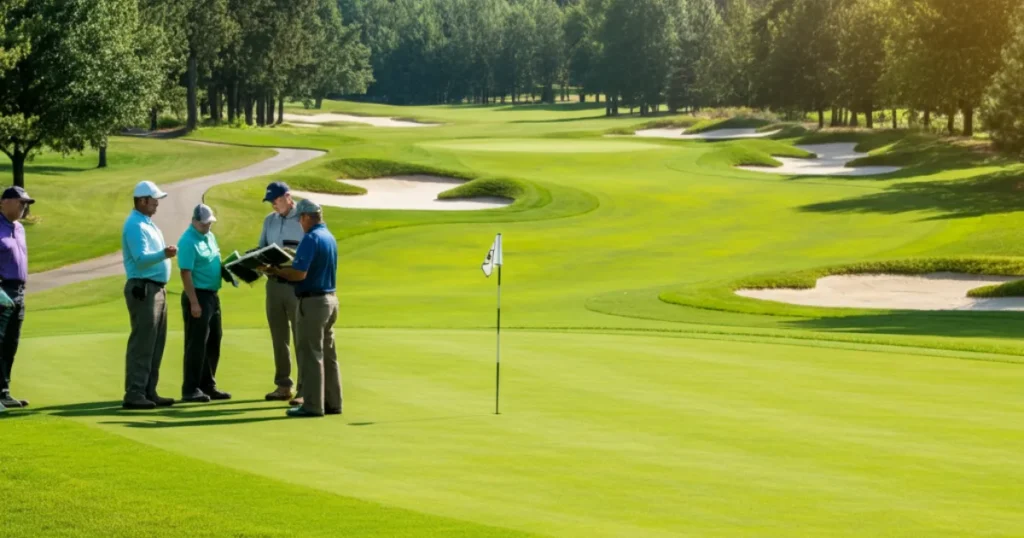When it comes to creating high-performing, visually stunning green spaces, the right turf can make all the difference. Whether you’re managing a golf course, landscaping a public park, or building a world-class sports field, choosing and maintaining the perfect turf requires expertise. This comprehensive guide will walk you through everything you need to know about expert turf—from types and installation to maintaining its brilliance and future trends in turf technology.
By the end of this blog, you’ll have actionable tools and tips to maximize your turf investment for long-lasting results.
Understanding Different Types of Turf
No two turf applications are the same, and selecting the right turf for your project depends heavily on its intended use and environmental conditions. Here’s an overview of the most popular options:
Natural Turf
Best for: Golf courses, large parks, sports fields.
Natural turf offers unparalleled aesthetics, superior playing surfaces, and excellent ecological benefits like oxygen production. However, it requires intensive maintenance, including regular mowing, fertilization, and pest control.
Examples:
- Bentgrass for golf greens due to its smooth texture and striking color.
- Kentucky Bluegrass for its hardiness and versatility in harsh climates.
Synthetic Turf
Best for: High-traffic sports fields, low-maintenance public spaces.
While artificial turf lacks the natural feel and ecological benefits, it’s an efficient, low-maintenance option. Modern innovations, like shock-pad underlays, make synthetic turf suitable even for premium sports.
Examples:
- Polyethylene fibers for their soft texture (ideal for sports fields).
- Nylon turf for commercial applications requiring durability.
Hybrid Turf
Best for: Professional sports stadiums and premium landscapes.
Combining natural grass and synthetic fibers, hybrid turfs offer the best of both worlds. They’re visually appealing yet resilient under heavy wear, which is why they’re increasingly popular in soccer and football stadiums.
Soil Preparation and Installation
Proper installation directly influences the performance and longevity of your turf. Follow these key steps for successful turf application:
Step 1: Soil Analysis
Start with a comprehensive soil test. Determine pH levels, nutrient content, and drainage properties. For instance:
- Golf courses may require well-draining sandy soils.
- Sports fields need soil with high nutrient retention for intense upkeep schedules.
Step 2: Clear and Grade the Area
Remove any debris, rocks, or weeds from the area. Ensure the ground is level or has proper slopes for controlled water drainage.
Step 3: Install Appropriate Base Layers
For natural turf, add organic topsoil and level with precision. For synthetic turf, use compacted gravel coupled with shock-absorbent underlays for athlete safety.
Step 4: Lay the Turf
Unroll turf sections and carefully stitch (or seam tape in the case of synthetic turf). Finish by rolling over the surface to flatten and eliminate air pockets.
Maintenance Tips for Longevity
Even the highest-quality turf requires regular care to stay immaculate. Here’s how to maintain it effectively:
Maintenance for Natural Turf
- Mowing: Mow at least once a week during peak growing season to maintain uniform height.
- Irrigation: Ensure deep watering early in the morning to prevent fungal growth.
- Aeration: Schedule annual aeration to improve root growth and breathability.
- Fertilization: Use slow-release fertilizers, especially for high-intensity areas like fairways.
Maintenance for Synthetic Turf
- Cleaning: Remove debris and rinse with water weekly to prevent dust accumulation.
- Brushing: Brush the fibers regularly to maintain their upright position.
- Deep Cleaning: Use a special turf vacuum for deep cleans every few months.
- Inspection: Look for loose seams or wear and repair them promptly.
Common Turf Problems and Solutions
Even a perfectly installed and maintained turf can face issues. Here’s a rundown of common problems and how to tackle them:
For Natural Turf:
- Weeds: Apply pre-emergent herbicides in early spring.
- Pests: Use eco-friendly pesticides or introduce natural predators like ladybugs for aphids.
- Diseases (e.g., Fusarium or Necrotic Ring Spot): Fungicides paired with soil pH adjustments can help combat fungal infections.
For Synthetic Turf:
- Odors: Use enzyme cleaners to neutralize bacteria buildup.
- Wear and Tear: Repair damaged patches promptly with seam tape and adhesive.
Expert Advice on Choosing the Right Turf
Your choice of turf should align with factors like climate, use case, and maintenance resources. Here’s how to narrow down your options:
- Assess Environmental Conditions: For wet climates, choose hardy grasses like Fescues. For hot, dry zones, Bermuda Grass performs well. Synthetic turf is ideal for reducing water consumption in drought-prone areas.
- Understand Usage Demands: Golf greens require smooth textures like Bentgrass, while football fields may benefit from hybrid turf, offering durability under spikes and studs.
- Evaluate Budget: Natural turf generally has higher maintenance costs long-term, while synthetic turf requires upfront investment but pays off in low upkeep.
Case Studies: Successful Turf Applications
Learning from real-world examples can guide your decision-making. Here are two applications where expert turf transformed spaces:
- Champion Golf Course Greens: A golf club in California replaced its aging natural greens with disease-resistant Bermuda Grass, significantly reducing maintenance costs while improving aesthetics and playability.
- Soccer Stadium Redesign: A stadium in the UK adopted hybrid turf to meet FIFA standards for player safety and durability. The switch halved ground repair costs and extended usability.
The Future of Turf Technology
Turf technology is evolving, offering exciting opportunities for landscaping and sports field professionals:
- Smart Irrigation Systems: AI-driven systems monitor soil moisture and optimize watering schedules to conserve water.
- Eco-friendly Synthetic Turf: Manufacturers are utilizing recycled and biodegradable materials for more sustainable installations.
- Robot Mowers: Autonomous mowers programmed via GPS are revolutionizing turf maintenance.
With advancements like these, maintaining high-quality turf will become more efficient, cost-effective, and environmentally conscious.
Maximize Your Turf Investment with Expert Care
From selecting the right type of turf to mastering its maintenance, the key to a successful turf installation lies in careful planning and execution. By implementing emerging technologies and expert techniques, you can ensure your green spaces remain lush, durable, and visually stunning.
For personalized advice or to explore the latest turf solutions, connect with one of our expert consultants today. Together, we’ll help you achieve your vision and maximize your turf investment.







